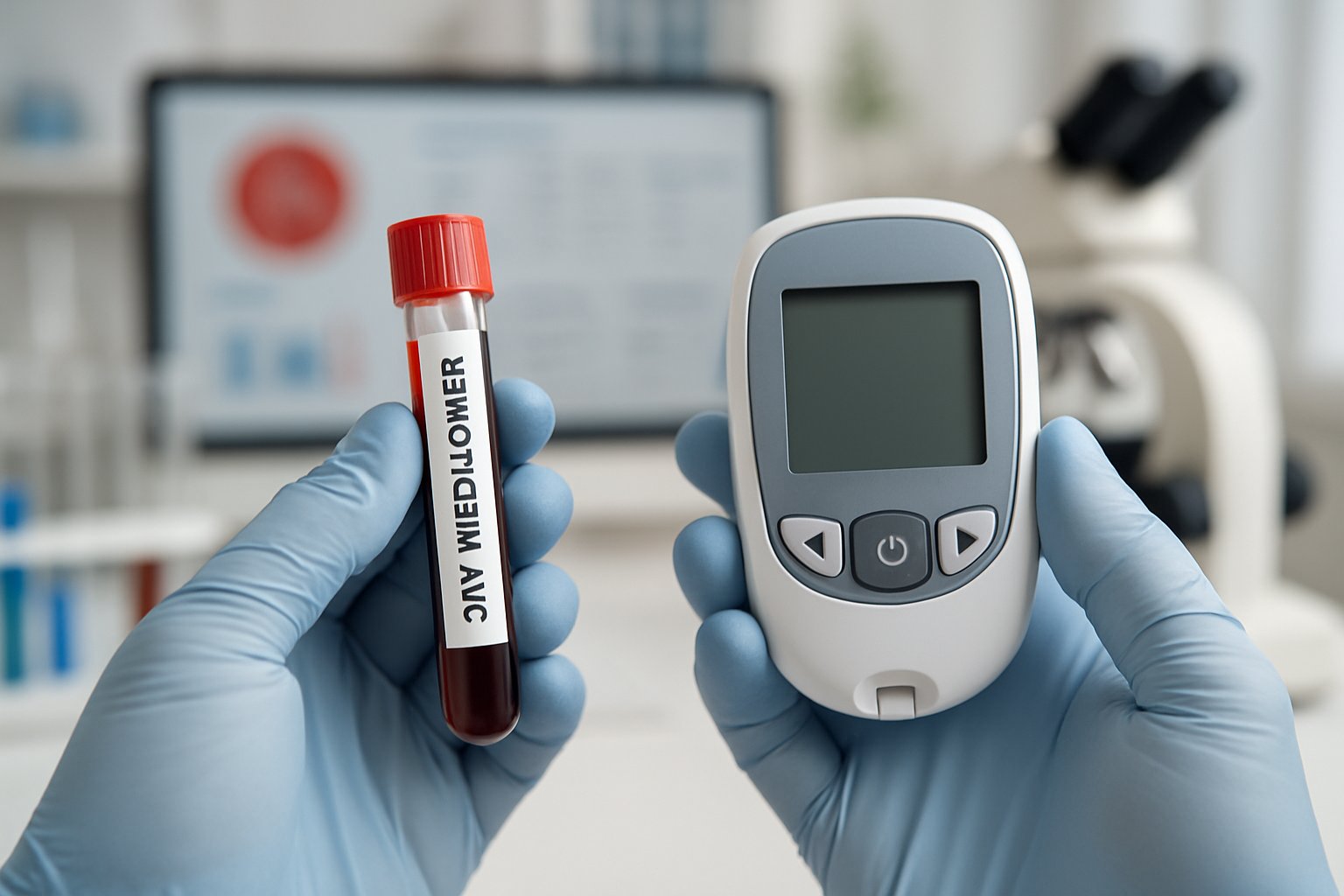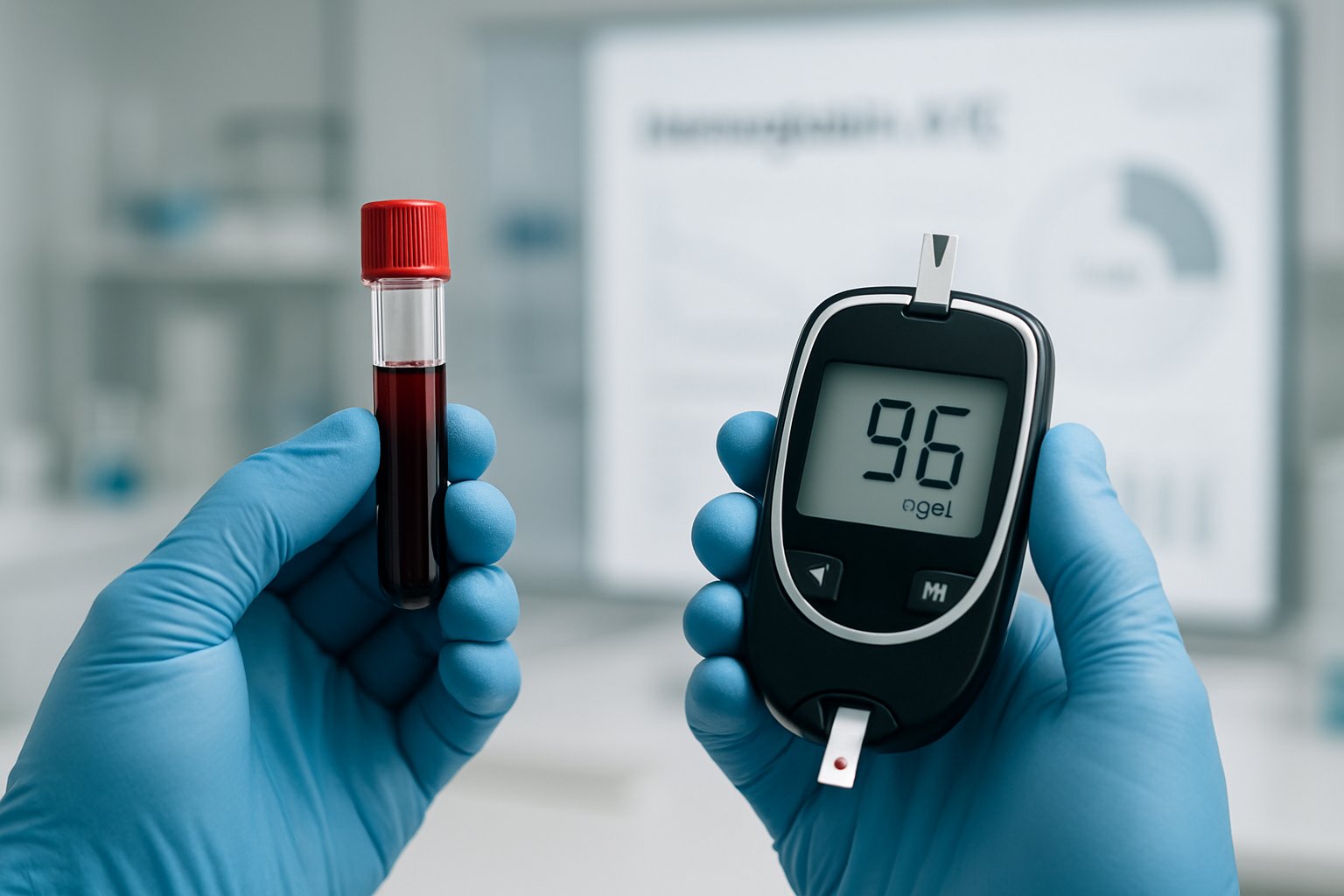Most people worry about high blood sugar levels, but having a very low A1C can also signal health problems that need attention. While a low A1C typically shows good blood sugar control, extremely low levels may indicate dangerous hypoglycemia episodes, underlying health conditions, or overly aggressive diabetes treatment.
Low A1C levels can pose potential risks[1] beyond what many patients and healthcare providers initially consider. For people with diabetes, frequent low blood sugar episodes can lead to serious complications including seizures, loss of consciousness, and even life-threatening situations.
Understanding what causes low A1C levels and recognizing the warning signs helps people make informed decisions about their health management. Whether someone has diabetes or not, knowing when A1C levels drop too low can prevent dangerous health outcomes.
Key Takeaways
- Extremely low A1C levels can indicate dangerous hypoglycemia episodes that require medical attention
- People with diabetes may need insulin dose adjustments if their A1C drops too low from frequent blood sugar dips
- Certain health conditions and medications can cause unexpectedly low A1C readings in both diabetic and non-diabetic individuals
What Is Hemoglobin A1C and How Is It Measured?

Hemoglobin A1C is a protein in red blood cells that binds with glucose over time, creating a marker that doctors use to track blood sugar control. The HbA1c test measures this glucose-bound hemoglobin to show average blood sugar levels over the past 2-3 months.
Role of Hemoglobin in Blood Sugar Testing
Hemoglobin carries oxygen through the bloodstream in red blood cells. When glucose in the blood comes into contact with hemoglobin, it sticks to the protein permanently.
This process happens naturally in everyone. The amount of hemoglobin A1c depends on blood glucose levels[2] – higher blood sugar means more glucose attaches to hemoglobin.
Red blood cells live for about three months before they die. During this time, glucose continues to bind to the hemoglobin inside these cells.
Key advantages of hemoglobin A1C testing:
- Shows long-term blood sugar patterns
- Not affected by recent meals or stress
- Provides more stable results than daily finger stick tests
- Requires only one blood draw
The A1C test measures glucose attached to hemoglobin over time[3], making it different from regular blood sugar tests that show only current levels.
How the HbA1c Test Reflects Blood Sugar Levels
The HbA1c test works by measuring what percentage of total hemoglobin has glucose attached to it. This percentage directly relates to average blood sugar levels over 8-12 weeks.
Higher blood glucose levels mean more sugar molecules stick to hemoglobin proteins. The higher the blood sugar, the higher the amount of hemoglobin A1c[2].
The test requires no special preparation. Patients do not need to fast because the test measures long-term averages, not current blood sugar.
HbA1c to Average Blood Sugar Conversion:
| A1C Level | Average Blood Sugar |
|---|---|
| 6% | 135 mg/dL |
| 7% | 170 mg/dL |
| 8% | 205 mg/dL |
| 9% | 240 mg/dL |
This relationship helps doctors and patients understand what A1C numbers mean in terms of daily blood sugar control.
Interpreting A1C Ranges and Results
Normal A1C levels range from 4% to 5.9%[2] in people without diabetes. These ranges help doctors diagnose and monitor diabetes and prediabetes.
Standard A1C Interpretation:
- Below 5.7%: Normal blood sugar levels
- 5.7% to 6.4%: Prediabetes range
- 6.5% or higher: Diabetes diagnosis
For people with diabetes, the target A1C level is usually below 7%. This goal may vary based on individual health factors and doctor recommendations.
Well-controlled diabetic patients have A1C levels less than 7.0%[2], while poorly controlled diabetes shows levels of 8.0% or above.
A1C levels above 9% are considered dangerous. These high levels increase the risk of serious complications like kidney damage, vision problems, and heart disease.
The test provides valuable information for treatment decisions. Small improvements matter – reducing A1C by just 1% can lower complication risks significantly.
Defining Low Hemoglobin A1C: What Does Low Really Mean?

Low A1C blood levels[4] occur when HbA1c measurements fall below normal ranges, but determining what qualifies as “too low” depends on clinical context and individual factors. Medical professionals use specific thresholds to evaluate whether low readings indicate healthy glucose control or potential underlying health issues.
Clinical Thresholds for Low HbA1c
Most laboratories consider HbA1c levels below 4.0% as unusually low. Normal ranges typically fall between 4.0% and 5.6% for adults without diabetes.
Healthcare providers become concerned when A1c drops below 3.5%. This level may signal serious health problems rather than good glucose control.
Key Clinical Thresholds:
- Below 3.5%: Potentially dangerous, requires investigation
- 3.5% to 4.0%: Unusually low, may need medical evaluation
- 4.0% to 5.6%: Normal range for non-diabetic adults
Low hemoglobin A1c readings can result from medical conditions that affect red blood cell lifespan. Anemia, bleeding disorders, and kidney disease commonly cause falsely low results.
A1C Below 5.7%: Normal, Low, or Too Low?
A1c below 5.7% typically indicates normal glucose metabolism in healthy individuals. The American Diabetes Association classifies readings under 5.7% as normal.
For people without diabetes, A1c levels between 4.0% and 5.6% represent optimal glucose control. These values suggest the body effectively manages blood sugar levels.
A1C Categories:
| A1C Level | Classification |
|---|---|
| Below 4.0% | Unusually low |
| 4.0% – 5.6% | Normal |
| 5.7% – 6.4% | Prediabetes |
| 6.5% and above | Diabetes |
However, A1c below 4.0% may indicate health problems. Conditions like severe anemia or recent blood loss can artificially lower these measurements.
Athletes and people with excellent fitness levels sometimes show A1c values at the lower end of normal ranges. This typically reflects superior glucose metabolism rather than a medical concern.
False Low A1C Results and Red Blood Cell Turnover
Red blood cell turnover significantly affects HbA1c accuracy. The A1C test measures glucose attached to hemoglobin over time[3], making it dependent on normal red blood cell lifespan.
Conditions that increase red blood cell turnover create falsely low A1c readings. Hemolytic anemia, bleeding disorders, and certain medications accelerate red cell destruction.
Conditions Causing False Low Results:
- Hemolytic anemia
- Iron deficiency anemia
- Recent blood transfusions
- Chronic kidney disease
- Spleen disorders
Recent blood loss from surgery or injury also lowers A1c measurements. New red blood cells carry less glucose history, reducing overall HbA1c levels.
Certain genetic conditions affect hemoglobin structure, leading to inaccurate low A1c results. Sickle cell trait and thalassemia commonly interfere with standard A1c testing methods.
Healthcare providers may order alternative glucose tests when red blood cell abnormalities are suspected. Fructosamine or glycated albumin tests provide more accurate glucose monitoring in these situations.
Causes of Low Hemoglobin A1C

Several medical conditions and lifestyle factors can cause A1C levels to drop below normal ranges[4]. Frequent low blood sugar episodes, blood disorders, kidney problems, and certain medications are the main factors that lead to unexpectedly low A1C readings.
Frequent Hypoglycemia and Diabetes Management
People with diabetes often experience low A1C levels when they have too many hypoglycemia episodes. These low blood sugar events happen when diabetes medication doses are too high for their current needs.
Insulin and other diabetes medications can cause blood glucose to drop below 70 mg/dL repeatedly. When this occurs frequently, the average blood sugar over three months becomes lower than expected.
Common causes of frequent hypoglycemia include:
- Taking too much insulin or diabetes medication
- Skipping meals or eating less than usual
- Exercising more without adjusting medication doses
- Drinking alcohol without eating food
People who experience multiple low blood sugar episodes per week often develop A1C levels below 5.7%. Their bodies spend significant time in hypoglycemic ranges, which pulls down the three-month average that A1C measures.
Impact of Blood Disorders and Anemia
Blood disorders directly affect A1C test accuracy because the test measures glucose attached to red blood cells. When red blood cells have shorter lifespans or abnormal structures, A1C results become unreliable.
Anemia causes low A1C readings in several ways. Iron deficiency anemia, the most common type, can falsely lower A1C measurements. The test assumes red blood cells live for 120 days, but anemic patients often have cells that die sooner.
Hemolytic anemia creates particularly problematic readings. This condition destroys red blood cells faster than normal, meaning glucose has less time to attach to the cells. The result is an A1C that appears lower than actual blood sugar control would suggest.
Other blood disorders that affect A1C include:
- Sickle cell disease
- Thalassemia
- Recent blood loss or transfusions
Effects of Chronic Kidney Disease and Other Medical Conditions
Chronic kidney disease significantly impacts A1C accuracy through multiple mechanisms. The kidneys normally filter waste products, but when they fail, toxins build up in the blood.
These toxins interfere with the A1C test process. Kidney disease also causes anemia, which further complicates A1C interpretation. Patients with advanced kidney disease often show A1C levels that don’t match their actual glucose control.
Liver disease affects how the body processes glucose and can lead to misleadingly low A1C values. The liver stores and releases glucose, so liver problems disrupt normal blood sugar patterns.
Other medical conditions that influence A1C include:
- Thyroid disorders
- Adrenal gland problems
- Severe infections
- Recent surgery or trauma
These conditions change how red blood cells function or survive, making A1C less reliable for tracking blood sugar control.
Medication and Lifestyle-Induced Low A1C
Certain medications beyond diabetes drugs can cause unexpectedly low A1C readings. Aspirin taken regularly may lower A1C measurements without actually improving blood sugar control.
Vitamin C and E supplements in high doses interfere with A1C testing methods. These antioxidants affect how glucose binds to hemoglobin, creating falsely low results.
Some people experience low A1C due to lifestyle factors:
- Very low carbohydrate diets that drastically reduce blood sugar
- Excessive alcohol consumption that damages red blood cells
- Extreme calorie restriction or eating disorders
Blood donation or recent blood loss can temporarily lower A1C by removing older red blood cells. New red blood cells have less time to accumulate glucose, resulting in lower test values for several weeks.
Pregnancy also affects A1C accuracy, particularly in the second and third trimesters when red blood cell turnover increases rapidly.
Symptoms and Health Risks of Very Low A1C Levels

Very low A1C can indicate issues like hypoglycemia[1], causing immediate symptoms like dizziness and confusion. Long-term risks include heart problems and kidney damage when blood sugar drops too frequently.
Recognizing Signs of Low Blood Sugar
Low blood sugar episodes create distinct warning signs that patients need to recognize quickly. Early symptoms include dizziness, confusion, and difficulty concentrating as the brain lacks adequate glucose.
Physical signs often appear next. People may experience sweating, shakiness, or rapid heartbeat. Hunger and irritability frequently occur during these episodes.
Mild to Moderate Symptoms:
- Dizziness and lightheadedness
- Confusion or trouble thinking clearly
- Difficulty concentrating on tasks
- Sweating without physical activity
- Trembling hands or body shaking
Vision problems may develop as blood sugar continues dropping. Some people report blurred vision or seeing spots.
Behavioral changes become noticeable to others. The person may seem anxious, irritable, or act differently than normal.
Severe Complications of Hypoglycemia
Untreated low blood sugar can progress to dangerous complications requiring immediate medical attention. Loss of consciousness represents a critical emergency situation.
Fainting episodes put people at risk for falls and injuries. The brain cannot function properly without adequate glucose supply.
Seizures may occur when blood sugar drops to extremely low levels. These neurological events can cause permanent brain damage if prolonged.
Emergency Symptoms Requiring 911:
- Loss of consciousness or inability to wake up
- Fainting spells
- Seizures or convulsions
- Severe confusion preventing normal function
Some people develop hypoglycemia unawareness over time. They stop feeling early warning symptoms, making severe episodes more likely.
Repeated severe episodes can impair cognitive function permanently. The brain suffers damage from repeated glucose deprivation.
Long-Term Risks: Heart and Kidney Disease
Frequent hypoglycemic episodes increase cardiovascular risks significantly. The stress of low blood sugar episodes strains the heart muscle over time.
Heart disease rates climb higher in people with repeated severe low blood sugar events. The cardiovascular system works harder to compensate for glucose shortages.
Blood pressure changes during hypoglycemic episodes affect kidney function. Kidneys filter blood less effectively when glucose levels fluctuate wildly.
Long-Term Complications:
- Increased heart attack risk
- Irregular heart rhythms
- Kidney damage from blood pressure swings
- Reduced kidney filtering ability
Kidney disease progresses faster when combined with frequent hypoglycemia. The organs cannot repair themselves between episodes effectively.
Diabetes complications may actually worsen despite lower A1C numbers. The body suffers damage from blood sugar instability rather than just high levels.
Dangers of Overly Aggressive Diabetes Treatment
An A1C far below 7% does not mean chances for complications will decrease[5] along with the lower numbers. Pushing A1C too low creates more risks than benefits for most patients.
Medication doses that are too high cause frequent hypoglycemic episodes. Insulin and diabetes drugs can drive blood sugar dangerously low when overdosed.
Risks of Overly Tight Control:
- Daily hypoglycemic episodes
- Emergency room visits
- Increased fall risk from dizziness
- Medication side effects
Healthcare providers must balance diabetes control with hypoglycemia prevention. Treatment goals should prevent both high and low blood sugar extremes.
Individual factors determine safe A1C targets for each person. Age, other health conditions, and hypoglycemia history all influence treatment decisions.
Who Is at Risk for Low Hemoglobin A1C?
Certain groups face higher risks for developing low A1C levels, including people with aggressive diabetes treatment plans and those with blood-related health conditions. Age and existing health problems also play important roles in determining risk levels.
People With Intensive Blood Sugar Control
People with diabetes who follow very strict blood sugar management often develop low A1C levels. This happens when diabetes management plans include multiple daily insulin injections or insulin pumps with frequent dosing.
Healthcare providers sometimes set very low blood sugar targets for their patients. These aggressive goals can push A1C levels below 5.0%, which may increase health risks.
High-risk diabetes treatments include:
- Multiple daily insulin shots
- Continuous insulin pump therapy
- Very low carbohydrate diets
- Frequent blood sugar monitoring with immediate corrections
People with prediabetes who make extreme lifestyle changes may also experience this issue. Cutting carbohydrates too drastically or exercising excessively can drop A1C levels too low.
Some people take diabetes medications even when their blood sugar is already normal. This often leads to A1C readings that fall below healthy ranges.
Individuals With Underlying Blood Disorders
Blood disorders directly affect how A1C tests work because they change red blood cell behavior. Low A1C levels often occur in people with anemia and larger red blood cells[6].
Common blood conditions that cause low A1C:
- Iron deficiency anemia
- Vitamin B12 deficiency
- Folate deficiency
- Chronic kidney disease
- Liver disease
People with these conditions may have A1C results that don’t match their actual blood sugar levels. The test becomes less reliable when red blood cells live shorter lives or have abnormal shapes.
Blood loss from surgery, injury, or heavy menstrual periods can also affect A1C readings. Recent blood transfusions make A1C tests less accurate for several months.
Some genetic conditions change how hemoglobin works in the body. These rare disorders can cause A1C levels that seem too low compared to daily blood sugar readings.
Specific Risk in Children, Elderly, and People With Comorbidities
Children with diabetes face unique risks for low A1C levels because their bodies process sugar differently than adults. Their faster metabolism and growth spurts can make blood sugar control unpredictable.
Parents often worry about high blood sugar and may give too much insulin. This creates a cycle of low blood sugar episodes that can drive A1C levels down too far.
Elderly people with multiple health conditions are at high risk. Their kidneys, liver, and other organs may not work as well, which affects how their bodies handle sugar and medications.
Elderly-specific risk factors:
- Slower kidney function
- Multiple medications
- Poor appetite
- Memory problems with medication timing
People with liver disease, kidney problems, or heart conditions often have low A1C levels that don’t reflect their true blood sugar control. These conditions change how long red blood cells survive in the bloodstream.
Cancer patients receiving chemotherapy may also develop artificially low A1C readings. The treatment affects blood cell production and can make test results unreliable.
Diagnosing and Monitoring Low HbA1c

Doctors use specific blood tests and monitoring devices to confirm low HbA1c levels and track changes over time. Healthcare providers play a key role in interpreting results and creating monitoring plans for patients with consistently low readings.
Tests Used to Investigate Low A1C
The HbA1c test measures average blood sugar[3] over the past three months. Doctors typically order repeat HbA1c tests to confirm low readings below 5.0%.
Additional blood tests help identify underlying causes:
- Complete blood count – checks for anemia or blood disorders
- Iron studies – measures iron levels and storage
- Liver function tests – evaluates liver health
- Kidney function tests – assesses kidney performance
- Vitamin B12 and folate levels – identifies nutritional deficiencies
Doctors may also order hemoglobin electrophoresis to detect abnormal hemoglobin types. This test helps rule out genetic conditions that affect hemoglobin structure.
Fasting glucose tests provide additional information about blood sugar control. These results help doctors determine if low HbA1c reflects actual low blood sugar or other factors.
Continuous Glucose Monitoring and CGM Devices
Continuous glucose monitoring provides real-time blood sugar readings throughout the day. CGM devices track glucose patterns that single blood tests might miss.
Modern CGM systems include:
| Device Type | Monitoring Duration | Key Features |
|---|---|---|
| Flash glucose monitors | 14 days | Scan-based readings |
| Real-time CGM | 7-14 days | Automatic alerts |
| Implantable sensors | 90+ days | Long-term monitoring |
Continuous glucose monitors help identify hypoglycemic episodes that occur without symptoms. The devices record glucose trends during sleep, exercise, and daily activities.
CGM data shows healthcare providers whether low HbA1c results from frequent low blood sugar episodes. This information guides treatment decisions and safety measures.
Role of Healthcare Providers in Ongoing Evaluation
Healthcare providers create personalized monitoring schedules based on individual patient needs. They typically recommend HbA1c testing every 3-6 months for patients with consistently low levels.
Doctors evaluate symptoms and medical history during regular appointments. They look for signs of underlying conditions that might cause low HbA1c readings.
Key provider responsibilities include:
- Interpreting test results in context of overall health
- Adjusting medication dosages when necessary
- Coordinating care with specialists
- Educating patients about warning signs
- Monitoring for complications
Primary care physicians often collaborate with endocrinologists for complex cases. Hematologists may join the team when blood disorders are suspected.
Regular follow-up appointments allow providers to track changes over time. They modify monitoring plans as patient conditions evolve or improve.
Managing and Preventing Low A1C Levels

People with diabetes need to adjust their treatment approach when A1C levels drop too low. Working with healthcare providers to modify medication doses and set appropriate blood sugar targets helps prevent dangerous hypoglycemia episodes.
Adjusting Glycemic Targets Safely
Healthcare providers may need to raise A1C targets for certain patients to prevent dangerous low blood sugar episodes. Older adults with diabetes may need higher targets around 8 percent instead of below 7[1] due to increased risks from hypoglycemia.
Children and teens often struggle with blood sugar management. They may require less strict A1C goals than adults.
People with heart disease or kidney problems face higher risks from low blood sugar. Their doctors typically set higher glycemic targets to maintain safety.
Common Adjusted A1C Targets:
- Older adults: 7.5-8.5%
- Children under 6: 7.5-8.5%
- Adults with severe health conditions: 7-8%
- Standard healthy adults: Below 7%
Patients should never adjust their own targets without medical supervision. Each person needs individualized goals based on their health status and risk factors.
Optimizing the Diabetes Management Plan
Insulin doses that don’t match the body’s needs can cause regular low blood sugar episodes[1]. Healthcare providers must carefully review and adjust diabetes medication to prevent this problem.
Testing blood sugar more frequently helps identify patterns of hypoglycemia. Continuous glucose monitors provide real-time data about blood sugar trends throughout the day.
Modern insulin pumps can work with glucose monitors to automatically adjust insulin delivery. These automated systems help maintain stable blood sugar levels while reducing hypoglycemia risk.
Meal timing and carbohydrate counting play crucial roles in preventing low A1C levels. Patients need consistent eating schedules that match their medication timing.
Exercise plans require coordination with insulin doses. Physical activity can lower blood sugar for hours after completion.
Collaborating With Healthcare Teams
Regular check-ins with diabetes specialists help identify A1C levels that are dropping too low. Healthcare providers can recommend glucose meters or continuous monitors to track blood sugar patterns more closely[1].
Endocrinologists specialize in hormone disorders like diabetes. They can make complex medication adjustments that family doctors might not feel comfortable managing.
Diabetes educators teach patients how to recognize early signs of hypoglycemia. They also provide training on proper use of glucose monitoring devices.
Pharmacists can review medication timing and interactions. They often catch potential problems that could contribute to unstable blood sugar levels.
Key Team Members:
- Endocrinologist or diabetes specialist
- Certified diabetes educator
- Pharmacist
- Primary care physician
- Dietitian
Patients should report any symptoms of frequent low blood sugar immediately. Quick communication prevents dangerous complications and allows for prompt treatment adjustments.
Frequently Asked Questions

Low A1C levels can signal serious health problems and may indicate underlying medical conditions. Understanding the risks, symptoms, and causes helps people recognize when to seek medical attention.
What health risks are associated with a dangerously low A1C level?
Dangerously low A1C levels can indicate severe hypoglycemia episodes that damage the brain and heart. These episodes may cause seizures, loss of consciousness, or even coma in extreme cases.
Low A1C readings might also signal malnutrition or severe illness. The body may not be processing glucose properly, which affects vital organ function.
People with very low A1C levels face increased risk of cognitive problems. Memory issues and difficulty concentrating can develop when blood sugar drops too frequently.
Can a low A1C level be indicative of any medical conditions or illnesses?
Liver disease can cause low A1C levels because the liver stores and releases glucose. When the liver doesn’t work properly, it affects how the body manages blood sugar over time.
Kidney disease may also lead to lower A1C readings[3]. The kidneys help filter blood and maintain proper glucose levels in the body.
Anemia affects A1C test results because it changes how long red blood cells live. This condition can make A1C levels appear lower than they actually are.
Certain cancers and autoimmune diseases may cause unexpectedly low A1C results. These conditions often affect how the body processes and uses glucose.
What symptoms might indicate that an individual has a lower than normal A1C level?
Frequent episodes of shakiness, sweating, and dizziness may indicate low A1C levels. These symptoms happen when blood sugar drops below normal ranges regularly.
Extreme hunger and food cravings often occur with low A1C readings. The body signals for more glucose when levels stay too low for extended periods.
Fatigue and weakness throughout the day can signal problems with blood sugar control. People may feel tired even after eating meals or getting enough sleep.
Difficulty thinking clearly or confusion may develop with consistently low blood sugar. Brain function depends on steady glucose levels to work properly.
How can having a low A1C affect one’s overall health and well-being?
Low A1C levels can disrupt sleep patterns and cause night sweats or restless sleep. The body works harder to maintain proper glucose levels during rest periods.
Energy levels may fluctuate wildly throughout the day. People often experience sudden crashes in energy followed by periods of feeling normal.
Work performance and daily activities may suffer when A1C levels stay too low. Concentration problems and mood swings can interfere with normal functioning.
Social relationships may be affected by unpredictable symptoms. Friends and family might not understand the physical challenges that come with low A1C levels.
What are the potential causes behind an unexpectedly low A1C result?
Taking too much diabetes medication can drive A1C levels below normal ranges. Insulin doses that are too high or frequent can cause dangerous blood sugar drops.
Severe calorie restriction or eating disorders may lead to low A1C readings. The body doesn’t receive enough glucose from food to maintain normal levels.
Excessive alcohol consumption affects how the liver processes glucose. Heavy drinking can interfere with the body’s ability to maintain steady blood sugar levels.
Recent blood loss from surgery, injury, or donation can temporarily lower A1C results. New red blood cells haven’t had time to accumulate glucose markers yet.
How is the treatment approach adjusted for patients with low A1C readings?
Doctors typically reduce diabetes medications when A1C levels drop too low. Insulin doses may be decreased or the timing of injections might be changed.
Meal planning becomes more important for people with low A1C levels. Eating regular meals with balanced carbohydrates helps maintain steady glucose levels throughout the day.
Blood sugar monitoring may need to increase temporarily. More frequent testing helps track patterns and prevent dangerous drops in glucose levels.
Treatment focuses on finding the right balance between controlling diabetes and avoiding hypoglycemia. Healthcare providers work with patients to adjust medications and lifestyle habits accordingly.
References
- Low A1C and Diabetes. https://www.everydayhealth.com/diabetes/can-your-a1c-be-too-low/ Accessed October 23, 2025
- Hemoglobin A1c Test: Levels, Normal, High, Low, Chart, Schedule. https://www.medicinenet.com/hemoglobin_a1c_test/article.htm Accessed October 23, 2025
- A1C: What It Is, Test, Levels & Chart. https://my.clevelandclinic.org/health/diagnostics/9731-a1c Accessed October 23, 2025
- About Low A1c Levels. https://healthanswers.pfizer.com/diabetes/self-care-living-with/about-low-a1c-levels Accessed October 23, 2025
- How Low Is Too Low When It Comes to A1c and Blood Sugar?. https://tcoyd.org/2024/02/how-low-is-too-low-when-it-comes-to-a1c-and-blood-sugar/ Accessed October 23, 2025
- Just a moment.... https://diabetesjournals.org/care/article/35/10/2055/38533/Low-Hemoglobin-A1c-in-Nondiabetic-AdultsAn Accessed October 23, 2025
